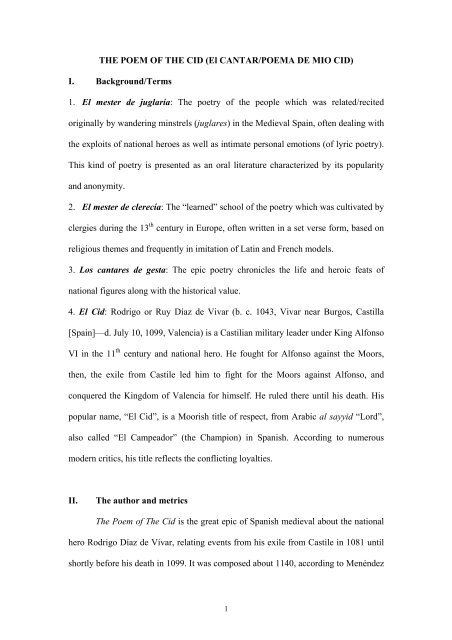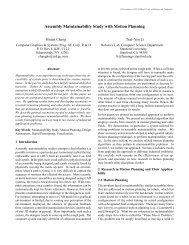THE POEM OF THE CID (El CANTAR/POEMA DE MIO CID) I ...
THE POEM OF THE CID (El CANTAR/POEMA DE MIO CID) I ...
THE POEM OF THE CID (El CANTAR/POEMA DE MIO CID) I ...
Create successful ePaper yourself
Turn your PDF publications into a flip-book with our unique Google optimized e-Paper software.
<strong>THE</strong> <strong>POEM</strong> <strong>OF</strong> <strong>THE</strong> <strong>CID</strong> (<strong>El</strong> <strong>CANTAR</strong>/<strong>POEM</strong>A <strong>DE</strong> <strong>MIO</strong> <strong>CID</strong>)I. Background/Terms1. <strong>El</strong> mester de juglaría: The poetry of the people which was related/recitedoriginally by wandering minstrels (juglares) in the Medieval Spain, often dealing withthe exploits of national heroes as well as intimate personal emotions (of lyric poetry).This kind of poetry is presented as an oral literature characterized by its popularityand anonymity.2. <strong>El</strong> mester de clerecía: The “learned” school of the poetry which was cultivated byclergies during the 13 th century in Europe, often written in a set verse form, based onreligious themes and frequently in imitation of Latin and French models.3. Los cantares de gesta: The epic poetry chronicles the life and heroic feats ofnational figures along with the historical value.4. <strong>El</strong> Cid: Rodrigo or Ruy Díaz de Vivar (b. c. 1043, Vivar near Burgos, Castilla[Spain]—d. July 10, 1099, Valencia) is a Castilian military leader under King AlfonsoVI in the 11 th century and national hero. He fought for Alfonso against the Moors,then, the exile from Castile led him to fight for the Moors against Alfonso, andconquered the Kingdom of Valencia for himself. He ruled there until his death. Hispopular name, “<strong>El</strong> Cid”, is a Moorish title of respect, from Arabic al sayyid “Lord”,also called “<strong>El</strong> Campeador” (the Champion) in Spanish. According to numerousmodern critics, his title reflects the conflicting loyalties.II.The author and metricsThe Poem of The Cid is the great epic of Spanish medieval about the nationalhero Rodrigo Díaz de Vivar, relating events from his exile from Castile in 1081 untilshortly before his death in 1099. It was composed about 1140, according to Menéndez1
Pidal, some 40 years after the death of the Cid. Nevertheless, the identity of the authorhas been ignored just like most of the old European epics did. Menéndez Pidalpresumed that a minstrel called San Esteban de Gormaz as well as the other oneMedinaceli intervened successively in its composition. Later, the poem was preservedin a copy by one Per Abbat, to whom nowadays critics consider as only a copist.The poem consists of 3,730 verses, written in irregular metrics, that is, with aversification that fluctuates between verses of different syllables, but with thedominance of those of 14.III.Content and structureThe poem relates some of the adventures of the Cid in his maturity, and it isdivided into three sections or cantos.1) <strong>El</strong> Cantar del desierto: It deals with the exile of the Cid from Castile after fallinginto the King’s disfavour. With deep sorrow and desperation, in Burgos the Cidfarewelled to his wife Jimena and his two daughters, to whom he entrusted the monksof Cardeña to take care of. Since then, he was accompanied by his faithfulsubordinates in the journey of the exile. They conquered numerous Moorish lands,offering gifts to the King to show the Cid’s high fidelity to the Monarch. Shortlyafterwards, defeated and captured the Count of Barcelona, who had the greatinfluence in the area of Valencia and to whom the Cid set free.(2) <strong>El</strong> Cantar de Las bodas: The Cid conquered Valencia and defeated the King ofSeville. King Alfonso was reconciled with the Cid and arranged the marriage of theCid’s two daughters (doña <strong>El</strong>vira and doña Sol) to the Princes (Infantes) of Carrión.(3) <strong>El</strong> Cantar de La afrenta (outrage, dishonor) de Corpes: The final part describesthe shameful behavior of the Infantes towards their wives and the Cid’s revenge upon2
them. All was due to a ridicule that the Princes, being coward in the battle, werefearful at the sight of a lion in front of the Cid’s courtesans. In order to take revenge,they left Valencia with their wives, while arriving at Corpes, abandoned them,whipped them cruelly. The Cid asked the King for the justice, summoned the court ofToledo, and the Cid’s warriors defeated the Princes. The poem ends with the newweddings of the Cid’s two daughters with the Princes of Navarra and Aragón.IV.The technique, style and significanceThe poem is notable for its realism and humanity---- with the characterizationof characters, especially of the Cid which portrays us a man of hero in the battle,delicate and affectionate in his private life, a faithful vassal to the King as well. In thisinstance, the work does not contain fantastic elements, but embraces a high value ofrealism and historicism due to the precision of its geographic allusions and of socialcustoms of that period. In terms of the style, compared to the French epic poems, ThePoem of the Cid is more spontaneous and more sober.In addition to its literary value, The Poem symbolizes the Castilian spirit, thesentiment of heroism in conjunction with the concept of democracy.On the other hand, the issue of historicism and fictionalization is fairlycontroversial. The Cid became a universal hero to the Spanish (thanks to the influenceof the 12 th - century epic poem of Castile), and his story was elaborated by numerousballads, legends, and other tales until the historical figure was almost completelyobscured by the fanciful literature. The Cid was speedily elevated to the status ofnational hero of Castile, but the legend played a dominant role in idealizing thecomplex heroic biography. The Cid was rescued from fiction by the Spanish scholar3
Ramón Menéndez Pidal, who devoted his entire long life to discovering the historicalCid and in portraying the Spain in which he lived.4
















